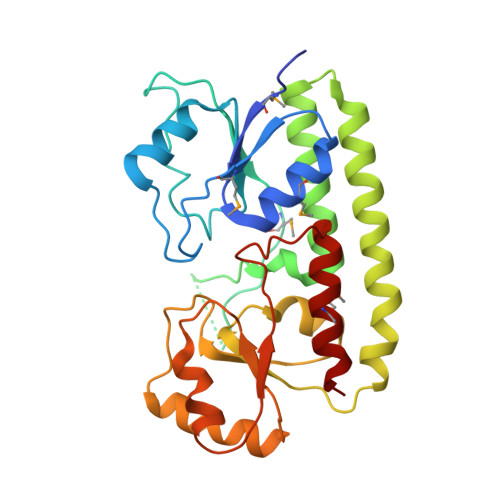AdcAII, a new pneumococcal Zn-binding protein homologous with ABC transporters: biochemical and structural analysis.
Loisel, E., Jacquamet, L., Serre, L., Bauvois, C., Ferrer, J.L., Vernet, T., Di Guilmi, A.M., Durmort, C.(2008) J Mol Biol 381: 594-606
- PubMed: 18632116
- DOI: https://doi.org/10.1016/j.jmb.2008.05.068
- Primary Citation of Related Structures:
3CX3 - PubMed Abstract:
Regulation of metal homeostasis is vital for pathogenic bacteria facing drastic metal concentration changes in various locations within the host during invasion. Metal-binding receptors (MBRs), one of the extracellular components of ATP-binding cassette transporters, have been shown to be essential in this process. Streptococcus pneumoniae expresses two characterized MBRs: PsaA and AdcA, two extracellular lipoproteins encoded by the psaABCD and adcRCBA operons, respectively. The Mn- and Zn-uptake functions of PsaA and AdcA, respectively, have been well established. Here we describe AdcAII as a third putative S. pneumoniae MBR. The analysis of a phylogenetic tree built from the sequence alignment of 68 proteins reveals a subgroup of members displaying an unusual genetic operon organisation. The adcAII gene belongs to a 6670-nucleotide-long transcript spanning the spr0903 to spr0907 loci encoding for the CcdA, thioredoxine, YfnA, AdcAII and PhtD proteins. Two adjacent repeats of imperfect AdcR-binding consensus sequence were identified upstream of the adcAII gene, suggesting a transcriptional co-regulation of adcAII and phtD genes. Biophysical and structural studies of recombinant AdcAII were performed to identify the metal specificity of the protein. Using electrospray mass spectrometry in native conditions, we found that Zn was bound to recombinant AdcAII. Screening of the effect of 10 cationic ions on the thermal stability of AdcAII revealed that Zn had the most pronounced stabilizing effect. The crystal structure of AdcAII has been solved to 2.4 A resolution. One Zn ion is bound to each AdcAII molecule in a symmetrical active site composed of three His and one Glu. The structure almost perfectly superimposed on the known MBR structures. The presence of a flexible 15-residue-long loop close to the metal-binding site is specific to those specialized in Zn transport. Taken together, these functional and structural data provide new perspectives related to the physiological role of AdcAII in pneumococcus Zn homeostasis.
Organizational Affiliation:
Institut de Biologie Structurale Jean-Pierre Ebel UMR 5075 (CNRS/CEA/UJF/PSB), Laboratoire d'Ingénierie des Macromolécules, 41 rue Jules Horowitz, 38027 Grenoble, France.

















